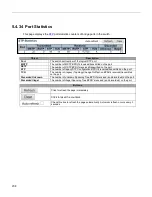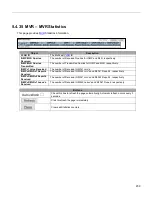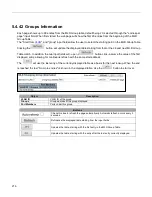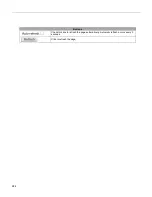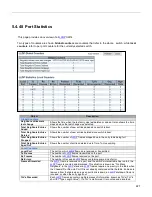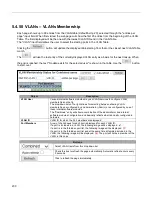
221
Application Type
Application Type
indicating the primary function of the application(s) defined for this
network policy, advertised by an Endpoint or Network Connectivity Device. The
possible application types are shown below.
1. Voice - for use by dedicated IP Telephony handsets and other similar appliances
supporting interactive voice services. These devices are typically deployed on a
separate VLAN for ease of deployment and enhanced security by isolation from data
applications.
2. Voice Signaling - for use in network topologies that require a different policy for the
voice signaling than for the voice media.
3. Guest Voice - to support a separate limited feature-set voice service for guest users
and visitors with their own IP Telephony handsets and other similar appliances
supporting interactive voice services.
4. Guest Voice Signaling - for use in network topologies that require a different policy
for the guest voice signaling than for the guest voice media.
5. Softphone Voice - for use by softphone applications on typical data centric devices,
such as PCs or laptops.
6. Video Conferencing - for use by dedicated Video Conferencing equipment and
other similar appliances supporting real-time interactive video/audio services.
7. Streaming Video - for use by broadcast or multicast based video content
distribution and other similar applications supporting streaming video services that
require specific network policy treatment. Video applications relying on TCP with
buffering would not be an intended use of this application type.
8. Video Signaling - for use in network topologies that require a separate policy for the
video signaling than for the video media.
Policy
Policy
indicates that an Endpoint Device wants to explicitly advertise that the policy is
required by the device. Can be either Defined or Unknown
Unknown: The network policy for the specified application type is currently unknown.
Defined: The network policy is defined.
TAG
TAG
is indicative of whether the specified application type is using a tagged or an
untagged VLAN. Can be Tagged or Untagged.
Untagged: The device is using an untagged frame format and as such does not
include a tag header as defined by IEEE 802.1Q-2003.
Tagged: The device is using the IEEE 802.1Q tagged frame format.
VLAN ID
VLAN ID
is the VLAN identifier (VID) for the port as defined in IEEE 802.1Q-2003. A
value of 1 through 4094 is used to define a valid VLAN ID. A value of 0 (Priority
Tagged) is used if the device is using priority tagged frames as defined by IEEE
802.1Q-2003, meaning that only the IEEE 802.1D priority level is significant and the
default PVID of the ingress port is used instead.
Priority
Priority
is the Layer 2 priority to be used for the specified application type. One of the
eight priority levels (0 through 7).
DSCP
DSCP
is the DSCP value to be used to provide Diffserv node behavior for the
specified application type as defined in IETF RFC 2474. Contain one of 64 code point
values (0 through 63).
Auto-negotiation
Auto-negotiation
identifies if MAC/PHY auto-negotiation is supported by the link
Summary of Contents for RGS Series
Page 7: ...7 Preface Scope Audience Safety Instructions Documentation Conventions ...
Page 9: ...9 Overview Overview Faceplate Panel Introduction ...
Page 13: ...13 Quick Installation Equipment Mounting Cable Connecting Equipment Configuration ...
Page 18: ...18 Figure 6 RGS200 12P Series Ground Connections ...
Page 36: ...36 5 2 1 Configuration Menu ...
Page 37: ...37 5 2 2 Monitor Menu ...
Page 38: ...38 5 2 3 Diagnostics Menu 5 2 4 Maintenance Menu ...
Page 54: ...54 5 3 12 Privilege Level This page provides an overview of the privilege levels ...
Page 238: ...238 Click to re start diagnostics with PING ...
Page 252: ...252 台灣 警告使用者 ...


